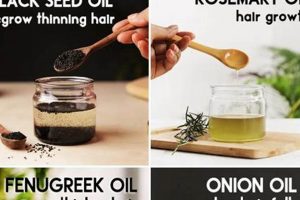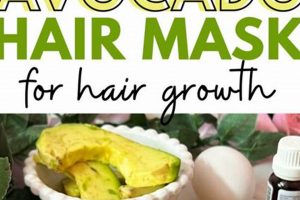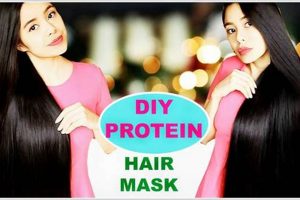The act of creating personalized hair treatments at home, utilizing readily available ingredients, constitutes a prevalent beauty practice. For example, combining avocado, honey, and olive oil can yield a nourishing treatment designed to hydrate and revitalize dry hair.
Formulating customized hair treatments provides advantages such as cost-effectiveness and control over ingredient selection, enabling avoidance of potential irritants or allergens. Historically, homemade beauty remedies have been employed across cultures, reflecting a desire for natural and personalized care solutions.
The subsequent sections will delve into ingredient selection, formulation techniques, application methodologies, and safety considerations relevant to producing effective homemade hair treatments.
DIY Hair Mask Formulation
The following guidelines offer crucial insights for individuals seeking to create effective and safe homemade hair treatments. Adherence to these principles will maximize potential benefits and minimize adverse reactions.
Tip 1: Ingredient Selection Based on Hair Type: Different hair types necessitate tailored ingredient profiles. For instance, oily hair may benefit from clay-based masks, while dry hair requires deeply moisturizing oils like argan or coconut.
Tip 2: Conduct a Patch Test: Prior to full application, a small amount of the prepared mask should be applied to an inconspicuous area, such as the inner arm. Observe for 24-48 hours for any signs of irritation or allergic reaction.
Tip 3: Employ Fresh, High-Quality Ingredients: The efficacy of the treatment is directly correlated with the quality of the components utilized. Opt for organic or minimally processed ingredients whenever feasible.
Tip 4: Proper Mixing and Consistency: Achieve a smooth, consistent texture to ensure even distribution and optimal absorption. Avoid lumps or separation, which can hinder the mask’s effectiveness.
Tip 5: Application Technique: Apply the mask evenly from root to tip, focusing on areas that require the most attention. Use a wide-tooth comb to ensure thorough coverage.
Tip 6: Appropriate Application Time: Adhere to the recommended application time; typically 20-30 minutes is sufficient. Prolonged exposure may not necessarily enhance results and, in some cases, could lead to adverse effects.
Tip 7: Thorough Rinse: Completely remove the mask from the hair with lukewarm water. Residual product can weigh down the hair and attract dirt and debris.
Tip 8: Frequency of Application: The optimal frequency depends on hair type and condition. Generally, once or twice weekly is sufficient for most individuals. Overuse can lead to buildup or imbalance.
Implementing these tips will contribute to successful creation and application of bespoke hair treatments, resulting in healthier, more vibrant hair.
The subsequent section will explore specific recipes tailored to address various hair concerns.
1. Ingredient Functionality
The efficacy of a homemade hair treatment is directly predicated upon the properties of its constituent ingredients. A lack of understanding regarding ingredient functionality may result in ineffective or even detrimental outcomes. For example, applying a protein-rich component to hair already experiencing protein overload can induce brittleness and breakage. Conversely, using solely humectants in a low-humidity environment can lead to moisture loss from the hair shaft. Proper ingredient selection, therefore, is not merely additive but a critical determinant of the treatment’s ultimate effect.
Real-life examples illustrate the significance of this knowledge. Coconut oil, often lauded for its moisturizing capabilities, can, in certain hair types, act as a protein blocker, hindering essential nutrient absorption. Similarly, apple cider vinegar, utilized for its clarifying properties, can disrupt the hair’s pH balance if applied improperly, leading to dryness and cuticle damage. To mitigate these potential issues, individuals must familiarize themselves with the specific actions and potential interactions of each ingredient included in the homemade preparation.
In summation, a thorough comprehension of ingredient functionality is indispensable for successful formulation of homemade hair treatments. The selection and combination of ingredients should be guided by a clear understanding of their individual properties and potential effects on diverse hair types. By prioritizing this knowledge, individuals can optimize the benefits of homemade treatments while minimizing the risk of adverse reactions, aligning practice with principles of effective haircare.
2. Recipe Formulation
Recipe formulation constitutes a core element within the realm of creating personalized hair treatments. The selection and proportioning of ingredients directly influence the treatment’s efficacy and suitability for specific hair types and conditions.
- Ingredient Ratios and Concentrations
The relative quantities of ingredients significantly impact the outcome. For instance, excessive amounts of essential oils can cause scalp irritation, while insufficient concentrations of moisturizing agents may fail to adequately hydrate dry hair. Accurate measurement and adherence to established guidelines are crucial for maintaining safety and effectiveness.
- Ingredient Compatibility and Synergy
Certain ingredients may exhibit synergistic effects when combined, enhancing their individual benefits. Conversely, incompatible ingredients can negate each other or create undesirable reactions. Researching potential interactions and understanding the chemical properties of each component is essential for optimizing the treatment’s overall performance.
- pH Balance Considerations
The pH level of the final formulation plays a critical role in maintaining hair health. Hair typically thrives within a slightly acidic pH range. Ingredients with extreme pH values can disrupt the hair’s natural balance, leading to damage or scalp irritation. Monitoring and adjusting the pH of the treatment is necessary to ensure optimal results.
- Stability and Shelf Life
Homemade formulations often lack the preservatives found in commercially produced products, making them more susceptible to degradation. Understanding the stability and shelf life of individual ingredients and the finished product is vital for preventing spoilage and ensuring safety. Proper storage and timely usage are essential for maintaining the treatment’s integrity.
The aforementioned facets collectively define the art and science of recipe formulation in the context of creating personalized hair treatments. Mastering these principles enables individuals to create bespoke formulations that effectively address specific hair concerns while minimizing potential risks. The benefits of a well-formulated recipe extend beyond mere aesthetic improvement, contributing to the long-term health and vitality of the hair.
3. Application Methodology
The effective implementation of homemade hair treatments relies significantly on the chosen application methodology. The manner in which a hair mask is applied directly influences the absorption of active ingredients, the distribution of the product, and ultimately, the overall outcome of the treatment.
- Preparation and Sectioning
Proper preparation, including detangling and sectioning of the hair, ensures even distribution of the mask. Failure to adequately prepare the hair can result in uneven coverage, with some areas receiving insufficient product and others being overloaded. For example, applying a mask to tangled hair may lead to product buildup in the knots, preventing thorough penetration. Consistent sectioning allows for targeted application, particularly beneficial for individuals with thick or long hair.
- Application Direction and Technique
The direction of application, whether from root to tip or vice versa, can influence the impact of the treatment. Applying from root to tip may be preferred for scalp treatments intended to stimulate hair growth or address dandruff. Conversely, applying from tip to root can concentrate moisturizing ingredients on the ends, which are often the driest and most damaged parts of the hair. The technique, such as massaging the product into the scalp or gently coating the strands, also plays a role in absorption and effectiveness.
- Duration and Occlusion
The prescribed duration of the application, often specified in the recipe, is critical. Allowing the mask to remain on the hair for an insufficient period may not permit adequate penetration of active ingredients. Conversely, leaving the mask on for an excessive duration can lead to adverse effects, such as protein overload or scalp irritation. Occlusion, the practice of covering the hair with a shower cap or warm towel, can enhance absorption by trapping heat and moisture. However, the appropriateness of occlusion depends on the specific ingredients and hair type.
- Rinsing and Follow-up Care
Thorough rinsing is essential to remove all traces of the mask from the hair. Residual product can weigh down the hair, attract dirt and debris, and potentially cause scalp irritation. The temperature of the water used for rinsing can also impact the outcome; lukewarm water is generally recommended to avoid stripping the hair of its natural oils. Follow-up care, such as the application of a leave-in conditioner or hair oil, can further enhance the benefits of the treatment and protect the hair from environmental stressors.
In conclusion, the success of a homemade hair treatment is not solely dependent on the quality of the ingredients or the precision of the recipe. The application methodology is a crucial determinant of the outcome. Adherence to proper preparation techniques, thoughtful application direction, appropriate duration and occlusion, and thorough rinsing procedures can significantly enhance the effectiveness of the treatment and contribute to healthier, more vibrant hair.
4. Hair Type Specificity
The selection and formulation of personalized hair treatments are fundamentally contingent upon hair type. Neglecting to consider hair type during the “hair mask diy” process can lead to ineffective results or, in some cases, adverse reactions. The inherent characteristics of different hair types necessitate tailored approaches to ensure optimal outcomes.
- Oily Hair Considerations
Individuals with oily hair require formulations that absorb excess sebum without stripping the hair of essential moisture. Ingredients such as clay, lemon juice, or apple cider vinegar can be incorporated to control oil production. However, overuse of these ingredients can lead to dryness and scalp irritation. Therefore, precise measurements and infrequent application are crucial. An example of an appropriate mask would include bentonite clay, diluted apple cider vinegar, and tea tree oil; application should be limited to the scalp and avoided on the hair shaft.
- Dry Hair Requirements
Dry hair necessitates intensely moisturizing and emollient-rich components. Ingredients such as avocado, honey, olive oil, and coconut oil can provide deep hydration and restore the hair’s natural oils. However, the overuse of heavy oils can weigh down fine hair and create a greasy appearance. A suitable mask would consist of mashed avocado, honey, and olive oil, applied liberally to the hair shaft and left on for an extended period, followed by thorough rinsing.
- Fine Hair Challenges
Fine hair requires lightweight formulations that add volume and body without causing buildup. Ingredients such as aloe vera, egg whites, and lemon juice can provide gentle cleansing and lift. Heavy oils and butters should be avoided, as they can flatten the hair and make it appear limp. An appropriate treatment might include aloe vera gel, egg white, and a few drops of lemon juice, applied to the roots and left on for a short duration to avoid weighing the hair down.
- Coarse Hair Solutions
Coarse hair can benefit from rich, nourishing treatments that smooth the cuticle and add manageability. Ingredients such as shea butter, coconut oil, and argan oil can provide deep conditioning and reduce frizz. Protein-rich ingredients, such as yogurt or eggs, can also strengthen the hair shaft and prevent breakage. A suitable mask could include shea butter, coconut oil, and yogurt, applied generously to the hair shaft and left on overnight for maximum hydration.
The preceding points underscore the critical importance of tailoring personalized hair treatments to specific hair types. By carefully considering the unique characteristics of each hair type and selecting appropriate ingredients and formulations, individuals can optimize the benefits of homemade hair treatments while minimizing the risk of adverse reactions. This deliberate approach ensures that the “hair mask diy” process is not only enjoyable but also effective in promoting healthy, vibrant hair.
5. Safety Protocols
The integration of rigorous safety protocols is paramount within the practice of homemade hair treatments. A direct correlation exists between adherence to these protocols and the minimization of potential adverse reactions stemming from improperly prepared or applied formulations. Failure to observe safety measures can result in outcomes ranging from mild skin irritation to severe allergic responses, thereby negating the intended benefits. The selection of appropriate ingredients, accurate measurements, and knowledge of potential allergens constitute essential elements of a secure treatment regimen. For example, the use of undiluted essential oils, without prior patch testing, can induce severe skin reactions in sensitive individuals. This underscores the necessity of informed decision-making and meticulous execution throughout the formulation and application processes.
Practical application of safety protocols extends to several key areas. First, the sourcing of ingredients must prioritize quality and purity to minimize the risk of contaminants or adulterants. Second, recipes should be followed precisely, avoiding improvisation without a thorough understanding of the potential consequences. Third, a patch test should be conducted before any new treatment is applied to the entire scalp or hair. This involves applying a small amount of the preparation to an inconspicuous area of skin, such as the inner arm, and observing for any signs of irritation or allergic reaction over a 24-48 hour period. Fourth, the pH level of the final formulation should be assessed, as extreme pH values can damage the hair and irritate the scalp. Finally, proper storage of ingredients and finished products is essential to prevent spoilage and contamination.
In summary, the effective implementation of safety protocols is not merely an adjunct to the practice of homemade hair treatments; it is an intrinsic component that safeguards against potential harm. The challenges inherent in “hair mask diy”, such as ingredient variability and the absence of standardized testing, necessitate a proactive and diligent approach to safety. By prioritizing safety at every stage of the process, individuals can mitigate risks, maximize benefits, and ensure that homemade hair treatments contribute positively to overall hair health. The link between safety protocols and the broader theme of responsible beauty practices is undeniable, emphasizing the importance of informed decision-making and meticulous execution.
6. Ingredient Sourcing
The origin and acquisition of components utilized in homemade hair treatments bear significant implications for product quality, efficacy, and ethical considerations. A comprehensive understanding of ingredient sourcing enables informed decision-making and fosters responsible consumption practices within the domain of “hair mask diy”.
- Organic vs. Conventional Ingredients
Organic ingredients, cultivated without synthetic pesticides or fertilizers, minimize exposure to potentially harmful chemicals. Conventional ingredients, while often more readily accessible and cost-effective, may carry residues of these substances. The selection between organic and conventional ingredients should be guided by individual preferences and concerns regarding environmental impact and potential health risks. For instance, using organic honey ensures that no pesticides are transferred to the scalp during treatment.
- Fair Trade Practices
The procurement of ingredients, such as shea butter or coconut oil, from developing countries necessitates scrutiny of fair trade practices. Ensuring that producers receive equitable compensation and operate under safe working conditions promotes ethical sourcing and supports sustainable development. Failure to prioritize fair trade can perpetuate exploitative labor practices and contribute to environmental degradation. Buying fair-trade shea butter helps to ensure that women producers in Africa receive a fair price for their labor.
- Local and Seasonal Availability
Sourcing ingredients locally and seasonally reduces transportation costs and environmental impact, while also supporting local economies. Utilizing seasonal fruits, vegetables, and herbs in homemade treatments aligns with principles of sustainable consumption and promotes freshness and potency. This approach fosters a connection to the natural environment and encourages responsible resource management. Using locally sourced strawberries for a hair mask in the summer reduces the carbon footprint associated with long-distance transportation.
- Purity and Authenticity Verification
Verifying the purity and authenticity of ingredients is crucial for ensuring product safety and efficacy. Adulteration or mislabeling can compromise the treatment’s intended benefits and potentially introduce harmful substances. Employing reputable suppliers and conducting independent testing, when feasible, can mitigate these risks. Purchasing essential oils from certified aromatherapy suppliers helps to verify their purity and therapeutic properties.
The aforementioned aspects of ingredient sourcing underscore its integral role in the “hair mask diy” process. By prioritizing ethical and sustainable procurement practices, individuals can enhance the quality and efficacy of their homemade treatments while contributing to a more responsible and equitable beauty industry. This holistic approach recognizes that the creation of personalized hair treatments extends beyond mere formulation, encompassing a broader commitment to environmental stewardship and social responsibility.
Frequently Asked Questions Regarding Homemade Hair Treatments
The following section addresses prevalent inquiries and misconceptions pertaining to the formulation and application of homemade hair treatments. The information provided aims to enhance understanding and promote safe and effective practices.
Question 1: Is the efficacy of homemade hair treatments comparable to that of commercially produced alternatives?
The efficacy of homemade hair treatments depends significantly on the quality and suitability of the ingredients, as well as the precision of the formulation. While commercially produced alternatives undergo rigorous testing and standardization, homemade treatments allow for customization and control over ingredient selection. However, it is crucial to acknowledge that homemade formulations may lack the advanced delivery systems and preservative agents found in commercial products, potentially affecting their overall effectiveness and shelf life.
Question 2: Are there specific hair types for which homemade treatments are ill-advised?
Individuals with certain scalp conditions or sensitivities may need to exercise caution when considering homemade hair treatments. Those with open wounds, infections, or known allergies to specific ingredients should avoid formulations containing those components. Additionally, individuals undergoing specific medical treatments, such as chemotherapy, should consult with a healthcare professional before incorporating homemade treatments into their hair care regimen.
Question 3: What is the optimal frequency for applying homemade hair treatments?
The frequency of application depends on the individual’s hair type, condition, and the specific ingredients used in the formulation. Generally, applying a homemade hair treatment once or twice weekly is sufficient for most individuals. Overuse can lead to product buildup or imbalances in the hair’s natural oils. It is advisable to observe the hair’s response to the treatment and adjust the frequency accordingly.
Question 4: How can one ensure the safety and stability of homemade hair treatments?
Ensuring safety and stability involves several key measures. First, ingredients should be sourced from reputable suppliers and stored properly to prevent spoilage. Second, recipes should be followed precisely, and any new ingredient should be patch-tested before widespread application. Third, homemade formulations generally lack preservatives and should be used within a short timeframe, typically a few days to a week, and stored in a cool, dark place.
Question 5: Can homemade hair treatments address severe hair damage or loss?
While homemade hair treatments can improve the overall health and appearance of hair, they are unlikely to resolve severe damage or hair loss stemming from underlying medical conditions. In such cases, professional medical evaluation and treatment are essential. Homemade treatments may serve as a complementary approach to support professional interventions, but they should not be considered a replacement for medical care.
Question 6: Is it necessary to adjust homemade hair treatment recipes based on seasonal changes?
Seasonal changes can impact hair’s moisture levels and overall condition. During drier months, the hair may benefit from more intensely moisturizing treatments, while during humid months, lighter formulations may be more suitable. Adjusting recipes to incorporate ingredients that address seasonal needs can enhance the effectiveness of homemade hair treatments.
In summary, the effective and safe utilization of homemade hair treatments requires informed decision-making, adherence to established safety protocols, and a comprehensive understanding of individual hair needs. These practices collectively contribute to optimal outcomes and minimize potential risks.
The subsequent section will provide specific recipes tailored to address various hair concerns.
Conclusion
The preceding exploration of “hair mask diy” has illuminated the complexities inherent in creating effective and safe personalized hair treatments. From meticulous ingredient selection to the implementation of stringent safety protocols, the process demands a comprehensive understanding of hair types, ingredient functionalities, and potential interactions. The information presented underscores the critical importance of informed decision-making and responsible formulation practices.
Continued adherence to these principles, coupled with ongoing research and adaptation, will ultimately determine the success and sustainability of this approach to hair care. The potential benefits of tailored treatments are substantial, but the responsibility for ensuring safety and efficacy rests squarely with the individual practitioner. The pursuit of healthy, vibrant hair through homemade remedies warrants a commitment to both knowledge and caution.







